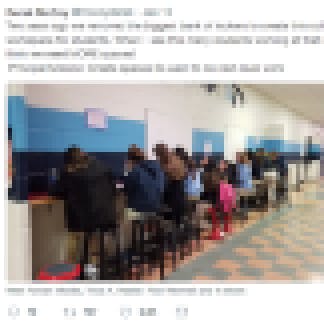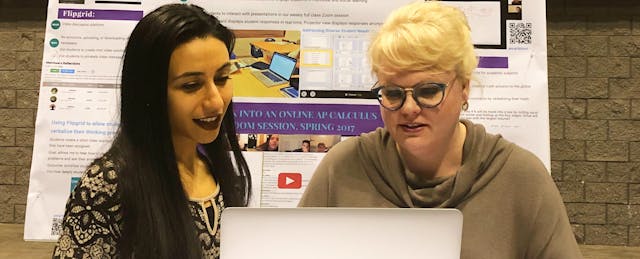The EdSurge Fusion conference back in October surfaced some unexpected “aha” moments for me. The theme was personalized learning and heading into the conference I anticipated gaining a broader view of technology products promising to provide adaptive learning experiences for all students. Instead, the deep conversations around professional learning for teachers left me wondering how I could redefine my role to better support teachers in making learning personal for students.
As a technology coordinator and math teacher, I work with both teachers and students, but I spend most of my day helping teachers meaningfully infuse technology into their classroom practices. After the conference, I began to consider the similarities between the relationship of student-to-teacher and teacher-to-technology coordinator—and how my role should shift too.
There is a lot of talk about how the role of the educator morphs to facilitator to meet the needs of students when implementing personalized learning—but it’s rare to see pointers for how the role of technology coordinators, integrators and coaches should shift to meet the needs of teachers during this transition. Perhaps it starts with rethinking these titles to better match the responsibilities of the position. Are we losing something by leading these titles with “technology?” Is there something to be gained by leading with “innovation,” “redesign” or “change-agent?”
To figure out how what changes to make, I reflected on my own journey as a teacher. At the start of my career, I wanted to control every step in the learning process so my students would always know I was right there to catch them should they stumble. I wanted them to feel confident and supported at every moment. As I’ve grown, I have realized that is not what great teaching is all about. Instead, it’s about empowering students by providing them with great resources and guidance, and then allowing them the time and space to find success on their own.
Transitioning from leader to facilitator has been transformative in my teaching. With that in mind, I find myself asking: How can I apply the transformation I've made in my work with students to my work with teachers?
Technology still provides many solutions for the challenges my teachers are faced with, but my approach to thinking about tech integration is wildly different from how I thought about it several years back. Instead of rooting my work in the effort to get students using the newly distributed laptops they are required to bring to school, my focus has shifted to providing more holistic professional learning on lesson redesign. Instead of simply helping teachers become more savvy using tech tools, I want to inspire them with ideas that allow them to create student-centered learning experiences. Here are a few big ideas I’m exploring as I rethink my role.
How Transforming the Physical Space Impacts Lesson Design
As schools transition to student-centered learning environments, we often see them redesign learning spaces. Walls come down to encourage fluid movement and collaboration, and the teacher’s desk is removed to put an end to rows of desks facing the “front” of the room. Traditional furniture is traded in for standing desks and rolling node chairs to empower students to learn in comfortable positions, and whiteboard space is replaced with windows to provide an abundance of natural lighting, which research shows increases student outcomes.
These are the kinds of changes we are making at Bullis School, in Potomac, MD.
Schools all over the country are looking to create flexible, open spaces in their schools for collaboration. But how do we help teachers fully realize the impact of these changes?

Physical alterations provide a great foundation for change, but true transformation will only happen when the teaching changes too. But how should teaching change and whose role is it to help teachers navigate the change process? I believe I should play an important part in this shift—so how do I tweak my tactics?
Take this simple issue: Without a desk at the front of the room, how do teachers redesign lessons so they can listen and students can talk?
Before I might have modeled a lesson standing at the whiteboard, engaging the class in a conversation on a given topic. We would unpack the problem as I scribbled on the whiteboard and used the projector at the front of the room. Were we using technology? Yep. Was the lesson student-centered? Nope. I needed to get them scribbling.
If the goal is for students to work with their peers and learn from one another, then the teacher needs to step away from the whiteboard.
With a more innovative space, and a focus on putting students at the center of learning, I might rethink this activity.
Maybe all students log into Pear Deck to engage with a series of questions with increasing complexity designed to encourage learners to make big picture connections on their own. In this scenario, each student can think and respond on their own device, but rather than responding in isolation, students work in pods and moments where students ask a neighbor for help are celebrated. As we tackle each question, student responses are displayed on the screens that surround the room so we can view and discuss the multiple approaches students took.
Now we see peer-to-peer learning in action.
From Bite-Size Tech Tips to Microcredentials
A year ago, I was sending teachers emails with a tech tip or bite-size PD activity focused on a particular tech tool. For example, after modeling the lesson using Pear Deck, I might have sent out a tip about an update or new feature with some instructions on how to use it.

Today, I am developing a series of mini-courses to help inspire teachers with bigger-picture ideas. My first one is a mini-course called “Layering in Metacognition Using Pear Deck,” which goes beyond a tutorial or set of tips for using the tool, to give teachers an opportunity to explore how to use it to help students learn howto learn—and they can earn a microcredential for their efforts.
In fact, we are creating a series of microcredential offerings for teachers at my school. We’re still marinating on how to incentivize teachers to earn them, and developing an implementation plan, but we’re very excited to see how this new approach supports innovative practices.

Redesigning Lessons With Students at the Center
There are edtech buzzwords that come and go, but I don’t believe that “student-centered” is one of them. At our school, we are making great strides putting students at the center of the learning environment, but it’s a big change and teachers deserve deep support and strong modeling.
Popular catch phrases such as “elevating student voice,” “taking ownership of learning,” “increasing student choice” and “shifting the role of teacher from leader to facilitator” are easier said than done. There is actually a substantial change process that needs to happen in order for teachers to be able to put each of these phrases into action.
When I first started my job, I was excited to share how leveraging technology could enhance existing practices, how it could help teachers gather data more effectively and efficiently and how it could be used to increase engagement.
Now, instead of focusing on what the teacher can add to their pre-existing lessons, I’m considering how we can leverage technology to design new kinds of lessons or to redesign existing ones to transform how students learn. This requires both the tactical work of thoughtful lesson planning as well as strong modeling of how to implement these new practices.
Teachers are expected to change so much about the way they teach and so the way they learn should change drastically in response. To honor that, I’m committing to taking some active steps toward transitioning from tech integration to being a leader in reshaping learning experiences to best meet the needs of our students.
Stacey Roshan is Upper School Technology Coordinator and Math teacher at Bullis School.


